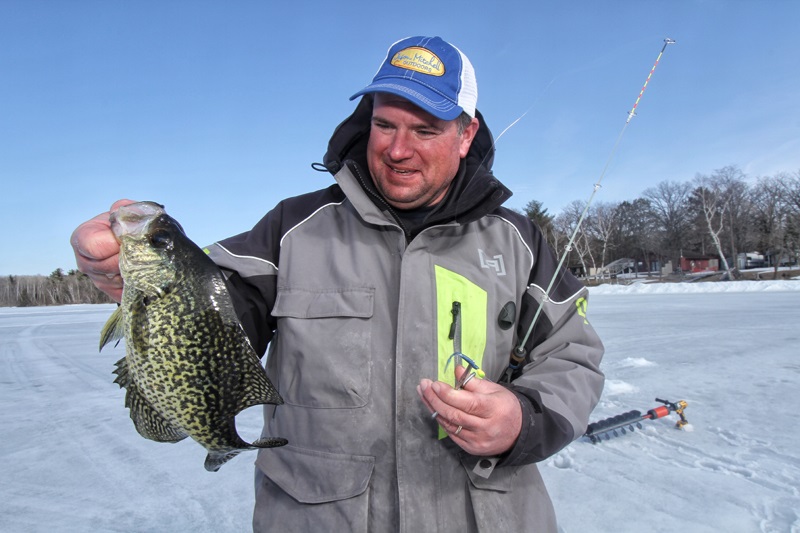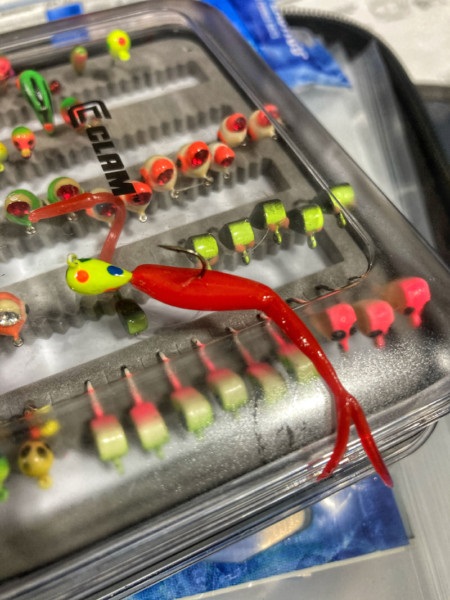
On so many natural lakes (particularly where there is good water visibility that typically creates lush stands of aquatic vegetation) crappie location at early ice is all about finding the best weeds. Tall green weeds will typically hold crappies at early ice and these locations can produce fish well into the winter. Finding crappie is often all about finding the best weeds. The weed line can vary from lake to lake but lakes that have good stands of weeds out to fourteen feet of water often produce a definite pattern. On some lakes, milfoil might be the prominent tall weed. Other lakes see stands of narrow leaf pondweeds and cabbage. Coontail can be excellent as well especially on sharp deep breaks. Typically, these weed locations can be big, sometimes stretching a hundred yards or more but there will be sweet spots within the weeds. Not all the weeds will be as dense for example or as tall. Find the spot on the spot where the weeds are densest and tallest and these spots will often recharge with fish continuously.
Finding the big spot can be relatively easy but it pays to spend time dialing in the spot on the spot. There are many ways to find the high batting average locations within these weed beds. At times especially during early ice, you can see the weeds frozen into the ice. Underwater cameras can also be extremely useful. Your sonar can also be used to find the tallest, thickest weeds in a spot. At times, you can physically look down a hole and see the weeds.
Tony Mariotti (from the Detroit Lakes region of western Minnesota) brought up a great point on a recent JMO Podcast when he described how he finds these locations in the fall out of a boat. Tony explained that many of the best cabbage locations on a lake are some of the best musky fishing spots. If you are serious about finding these locations, nothing is easier or faster than using a boat in the fall.
Typically, the tallest and best weeds are green but not always. Cabbage and pondweed break down fairly quickly and turns yellow or brown. From using an underwater camera, we have noticed many times when we found a lot of fish around yellow or brown weeds. As long as they are still standing tall and there is ample oxygen, which is pretty typical at early ice, crappies will sometimes be in weeds that are dying. I would simply argue that lush green weeds simply have the capability to hold fish much longer into the winter. Point being at early ice, green weeds are nice but not always necessary to develop a good pattern.
Crappies love cover and tall, dense weeds offer that cover. During the day especially with sun and high skies, crappies often lower down into the weeds. Low light and clouds might create windows where these fish cruise the open lanes and outside or inside edge next to the weeds. Light and time of day has a big bearing on strategy. Low light might mean you can sit in one hole and run traffic. High sun might mean you need to run and gun and really drill out a spot and drop the presentation in front of fish that aren’t moving.
Because of the environment, nothing in my mind beats a larger profile tungsten jig paired with a soft plastic. The added bulk and profile can be seen further away which can pull fish up out of the weeds. The added bulk also enables you to punch through the weeds to reach pockets below the top canopy. To be fair, spoons and horizontal swim lures will catch fish but when you have a treble hook on the presentation, you simply snag a lot more of the green stuff when you are trying to punch down past the tallest stalks of the weeds. Think of this presentation like punching a big heavy jig into milfoil to catch largemouth bass.

Low power or weed modes on your electronics is invaluable for fishing weeds and is why Vexilar is so popular with many ice anglers. You need to lower the power dramatically to tune out most of the weeds that cause clutter on your screen or dial. This enables you to see the open gaps between stalks and beneath the canopy. This also enables you to see fish move through these open gaps. Because the signal is analog or broadband versus digital, you can also pick up movement easier.
To explain this, imagine you have a series of orange and yellow marks that rise ten feet off the bottom that indicate the weeds. Imagine that there are three gaps that are a foot to two feet within the marks indicating openings within the weeds. You can see your lure or fish in the open gaps. What the analog or broadband signal enables you to do is see fish where there are lines indicating weeds because the signal will flutter and often change color to a stronger signal. You can actually look into the weeds much better because the Vexilar is better at picking up movement.
Underwater cameras can also be useful for not only finding weeds but getting a detailed picture of weeds and how fish are relating. There are times when you will see the fish with a camera but also look for cloudier water. If parts of the weed bed seem hazier where the visibility is greatly reduced, fish that spot because what I have found is that fish moving around in the weeds often creates that haze.
Learned a long time ago that you never say always or never with fishing but for finding crappies, a general rule of thumb is that the big crappies will be in the thick stuff during the day. Pike and bass populations often drive the panfish into hiding. The bigger panfish often seem to pick the best locations and the smaller fish get pushed out. If you are finding small bluegills in the area where you are fishing, keep exploring and find the spots within the area where there are thicker taller weeds.
There will often be clouds of small bluegills for example just hanging around these weed locations but the slabs are ruling the roost occupying the absolute best hiding spots. If there aren’t the occasional pike, bass or musky patrolling this weed spot, that dynamic can change but predators have a big influence on panfish location on many lakes.
These locations are usually solid well through early ice to the point these weed spots are often still holding fish by the time we are driving vehicles out on the ice. On most lakes, as winter progresses… many crappies will pull out of the weeds and suspend over basins or holes through the middle of winter. Some winters are different however if we get a mild winter where we don’t get a lot of ice or snow, these weeds will remain up and green through the winter and continue to hold fish. Thick stands of tall weeds however are always a great starting point on many lakes across the Midwest at early ice. If these weeds are present, there are usually fish.
Find more Jason Mitchell Outdoors including: blogs, videos, networks and airtimes at https://www.jasonmitchelloutdoors.com.
